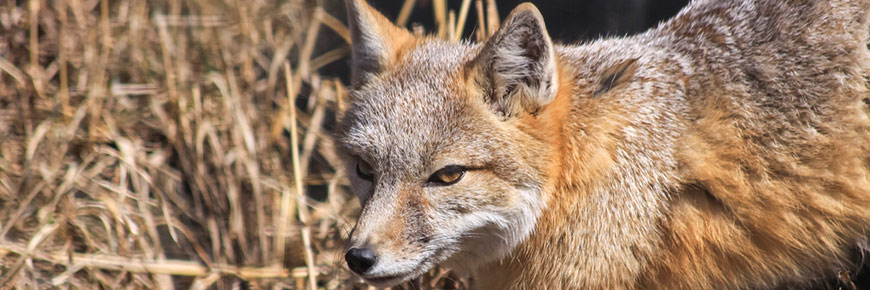
Johane Janelle / © Parks Canada
Swift Fox
Grasslands National Park
The Canadian Prairies were once home to the swift fox (Vulpes velox). Changes to the prairie, as a result of settlement, brought about the demise of this cat-sized canine by the late 1930's. Since 1983, captive bred foxes from Alberta and wild captured foxes from the United States have been released in Canada with varying degrees of success. The goal of the Swift Fox Recovery Team to have a viable, self-sustaining wild population by the year 2000 has been met as evidenced by the 2000 to 2001 census. With the help of the public, ranchers and other conservation groups, it is hoped that the swift fox will once again roam free on the Canadian prairies.
The swift fox is dependent on native short and medium mixed grass prairie for its survival. Sites with an open, unobstructed view are its preference. It is a nocturnal animal that uses several dens year round, often modifying abandoned badger holes. Rabbits, rodents, insects and birds are the major components of its diet.
The turn of the century brought about some major changes to the prairies. Native prairie rapidly disappeared to the plough and settlement that meant the disappearance of the bison, prairie wolf, plains grizzly and elk. The prairie ecosystem was permanently altered and the swift fox too, was threatened.
The swift fox fell victim to trapping, and was an accidental victim of poisoning campaigns aimed at coyotes and wolves. The swift fox is not a threat to farmers and ranchers. In fact, it is beneficial because the fox preys on insects, mice and other rodents. Habitat loss was once and continues to be the dominant factor in its decline. The ocean of grass that was once the north american prairies has been plowed, bulldozed and became fragmented. The ocean has become islands. Swift fox survival and the preservation of native prairie are tightly linked.
Predation and poisoning continue to be threats. Coyotes, badgers, and eagles all prey on the diminutive swift fox. Pesticides too, are a threat to the swift fox. Insects, containing pesticides from farm spraying are unwittingly eaten by the fox causing sickness and death.
The swift fox is part of a large and complex ecosystem. Its disappearance is an indicator of problems. Like losing the spoke of a wheel, without the swift fox and other prairie creatures, the prairie does not function properly. Its return to the prairies is a hopeful sign that things are being set right.
Habitat loss was once, and continues to be the dominant factor in its decline.
The Smeetons, from Cochrane, Alberta began captive breeding swift foxes in 1973 with the hopes of reintroducing them in the wild. Since then, the Smeetons have been joined by the Swift Fox Conservation Society, government agencies and concerned individuals in an effort to restore the lost element of the prairies.
Grasslands National Park of Canada (GNPC) is currently participating as a member of the Canadian Swift Fox team. Swift fox releases have been occurring in the East Block since 1990 and the West Block since 1992 up until 1997. Based on information gained from the 1996 to 1997 census, researchers estimate that 192 foxes live along the Alberta - Saskatchewan border south of Cypress Hills, and another 89 inhabit GNP. In 2000 to 2001, a new census was conducted of the same 1996 to 1997 study area including a new area in Montana. Researchers now estimate the swift fox population along the Alberta - Saskatchewan border to be 560 foxes, 96 foxes in the GNPC area, and 221 foxes in the newly surveyed Montana area. These numbers support the population of swift foxes to have tripled since the 1996 to 1997 survey. Their known distribution has also tripled as a result of the 2000 to 2001 census, spreading from 25 townships in 1996 to 1997 to 76 townships (including Montana) in 2000 to 2001. Through success of the Swift Fox Reintroduction Program, the Committee on the Status of Endangered Wildlife in Canada changed its listing from extirpated to endangered in 1998.
The difficulties in trying to reintroduce the swift fox demonstrates the complexity of natural systems. Co-operation between landowners, ranchers, hunters, farmers and the public is the key to its survival.
It is hoped that the gradual return of the age endearing swift fox is a sign of better things to come. Let us hope that the swift fox, and all native wildlife will be able to, once again, call the Canadian prairies their home.
The distinguishing features of the swift fox are black patches on either side of the snout and a black tip on its tail. The swift fox is one of the smaller members of the canid family, averaging about 2.5 kg. A red fox is nearly twice that and a coyote is nearly four times the weight of a swift fox. The summer coloration is usually pale yellow, buffy red, and tinged grey on the back with lighter sides and a white to pale yellowish brown underside. The tail is bushy and the ears are large, pointed and erect.
- Date modified :